4/11/2023 | Volume 26 issue 3
This newsletter and the advice herein are free. You usually get what you pay for.
Crop weather
Rainfall, air and soil temperatures, degree-days, soil moisture, and other current and historical weather data for the University of Minnesota Southwest Research and Outreach Center (SWROC), a little spot about two miles west of Lamberton, MN, can be found at https://swroc.cfans.umn.edu.
Although spring has been slow in arriving, recent warm weather is welcome. To the north, there is still meltwater from the Upper Minnesota drainage that will need to pass through here on its way to the Mississippi and the Gulf. The Cottonwood and other area streams are starting to fill but sloughs can still handle a bit more water. At the SWROC and area, there is still frost from 8 to 13” in spots and snow left on north-facing slopes and where the winds left deep drift.
I suspect some will be in the field sooner than here. There is no need to rush field work just yet. Local clay loam soils turn into a sticky problem if worked when cold and wet. They are going to need more dry, warm-weather days before any fieldwork can commence.
And now, submitted for your perusal, here is the IPM STUFF 2023 corn rootworm rant issue.
Corn rootworms (RW)
Western corn rootworms (WCR) and northern corn rootworms (NCR) are the 400-pound gorillas in MN corn insect management. Sure, they need some help from favorable weather, but high RW populations and resistance to Bt proteins are the unfortunate, but predictable, result of one-size-fits-all rootworm management. RW management practices should have an economic incentive, but often they are based on convenience rather than field-specific needs.
A few RW biology and management concepts
- Your ability to manage root injury from 2023 RW larvae is basically over once the field is planted. The rest of 2023 should be focused on 2024 RW management.
- RW problems are field specific. Rootworm populations differ across the corn belt. Don’t rely on information from areas or even your other fields when making rootworm decisions.
- Scouting is important. RW populations and resistance issues
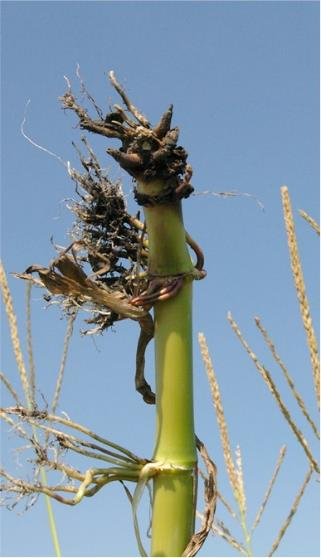
- often develop unnoticed. Problems lurking in a field can suddenly become obvious when RW populations increase.
- Scouting for beetles helps determine a field’s risk for RW injury the following growing season. The beetles found may have been produced in the scouted field or nearby.
- Root injury is an indication of the effectiveness of your RW management and potential resistance.
- Dry conditions can increase the impact of RW larval feeding on corn roots. Root lodging increases with wet soil and high winds.
- Both NCR and WCR are favored by long-term continuous corn production.
- Early and late-silking corn (including volunteer corn) attracts RW beetles.
- Crop rotation is your most powerful RW management tool. In Minnesota, WCR cannot survive in a field without a corn host. Although the NCR has adapted to crop rotation with extended diapause, much of the NCR population is likely still susceptible.
- In general, at-plant granular insecticides tend to be more consistent, a couple of the liquids can also perform well. Other liquids and RW-rate seed treatments provide lesser control.
- The performance of even the best RW insecticides will vary with weather, RW larval population density, and phenology.
- In susceptible rootworm populations, Bt is more efficacious and consistent than insecticides. Unfortunately, many of our RW populations, particularly WCR, are now much less susceptible to the Bt single traits and pyramids than they once were.
- In areas with high RW pressure and/or where Bt resistance is suspected, some growers add an at-plant insecticide to Bt-RW hybrids. Suspect a resistant rootworm population when a Bt hybrid benefits from the added insecticide. While layering an insecticide on a hybrid with RW traits can help maintain yield and reduce lodging. It is unlikely to affect resistance, or even the number of beetles emerging.
What about RW beetle control?
- Adult control with foliar-applied insecticides, a.k.a. “beetle bombing”, is a management option used by some growers.
- Silk clipping can prevent pollination, but this is rare, even with high RW populations.
- Adult control is one way to reduce larval pressure in the field when planted to corn the following year.
- Adult control can reduce egg-laying, but it is expensive and labor-intensive. Proper insecticide timing may not coincide with other operations such as foliar fungicide.
- Big planters and insecticide units have a hard time coexisting and force some growers into managing beetles with foliar insecticide.
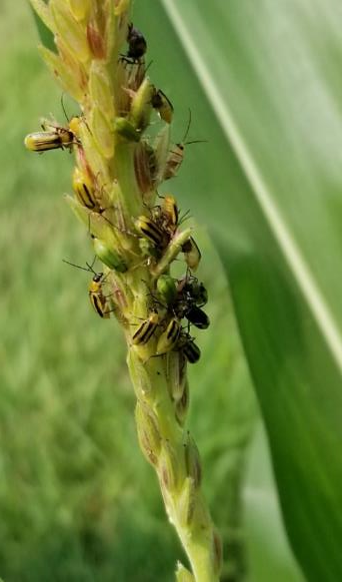
- Adult control is sometimes recommended in fields where very high RW pressure has overwhelmed Bt. It may reduce egg laying enough to allow another year of corn in the field, but it should not be expected to change the proportion of Bt-resistant RWs, and it will select for foliar insecticide resistance if the tactic is used often.
What about new technology?
- It might be wise to conserve the tools we have now.
- Perhaps, newer Group 20 insecticides (e.g., Nurizma™) can give us additional, effective insecticide tools. A couple of these will be included in the 2023 rootworm studies at Lamberton.
- I’m not privy to industry secrets but don’t expect new Bt proteins for RW control soon. We need to manage what we have for a few more years. The new RNAi (e.g., SmartStax Pro) technology will help but don’t expect any miracles.
- The RNAi technology prevents the RW larva from producing a protein that it needs to survive. An effective Bt base is needed to limit feeding injury until the slower-acting RNAi can kill the insect. What if the larvae are Bt-resistant?
- Planting an RNAi hybrid in fields with extremely high, Bt-resistant WCR populations risks unexpected injury from rootworms. These high populations can accelerate the development of field-evolved resistance for both Bt and RNAi.
- WCR has a long history of overcoming management practices. Betting RNA-resistant RW populations can’t/won’t develop might indicate a learning disability.
- Remember, rotating a field out of corn for a year is your most powerful management tool. Used wisely, it can help preserve your other RW management tools.
What about MN rootworm populations?
Checkoff funding from the MN Corn Research and Promotion Council has supported a network for monitoring populations of adult corn rootworms. For the past few years, yellow sticky traps managed by crop consultant, seedequal opportunity industry, extension, and farmer cooperators have tracked RW populations in MN corn fields for the past few years. This network has provided some rather interesting and concerning information.
The relative locations and RW beetle captures for 2021 and 2022 are shown in Fig. 3. Take note that many cooperators chose to put the traps in fields they perceived would be higher risk. I sure hope that overall populations are lower than reflected by the network.
The 2023 trapping results continue to show high RW beetle populations. Due to the relatively mild winter temperatures and snow cover, RW populations are expected to remain high in 2023. Larval mortality might still occur if soils are saturated when RW eggs hatch, but fields flooded in early June seldom produce optimal corn yields.
Not all fields need RW control. Many trapped fields captured no or very few RW beetles.
Trap data continues to suggest that rootworm management should be field-specific. Crop rotation is a major driver for RW populations of both species (Table 1.) but even some non-rotated fields have very low populations.
Table 2. shows a subset of the 2022 and 2023 trapping data. It shows the same relationship between RW beetles and crop rotation. More concerning is the number of WCR beetles captured in Bt hybrids. There is little difference between hybrids with and without Bt traits for rootworm control – a possible indication of widespread Bt resistance.
Figure 4 shows individual maximum daily trap captures for 2022. The average and medium captures for rotated corn are not unusual. However, those for non-rotated corn are very high, averaging above high risk (Table 1). In both rotations, there are fields with extremely high beetle populations (circled). Bt and insecticide may not be enough to adequately control these extreme populations. If the RW population in the field is resistant to Bt, hybrids with both Bt and RNAi traits might struggle as well. Rotation would reset these high WCR populations and can even reduce part of an extended diapause NCR population.
Left unmanaged, problem fields with extremely high populations affect other neighborhood fields as well. They produce large numbers of beetles to infest neighboring fields. Nearby rotated fields are re-infested more quickly and quite possibly with Bt-resistant beetles.
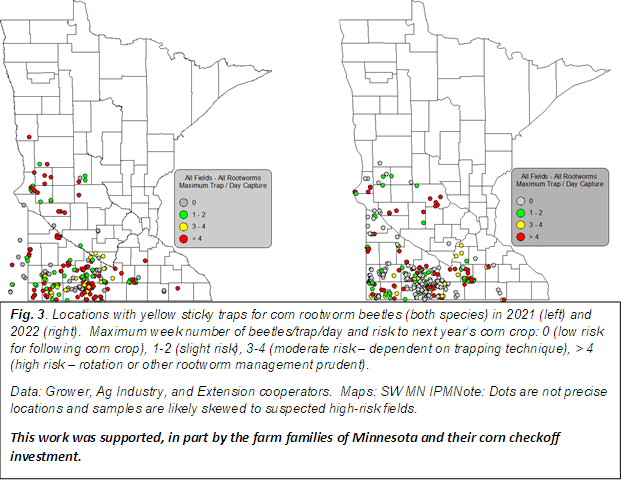

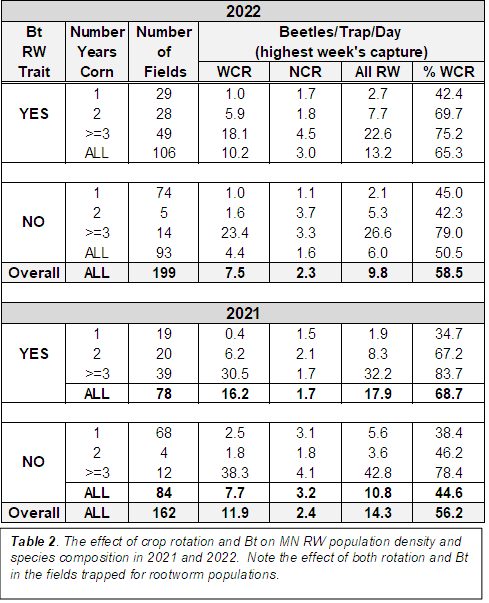
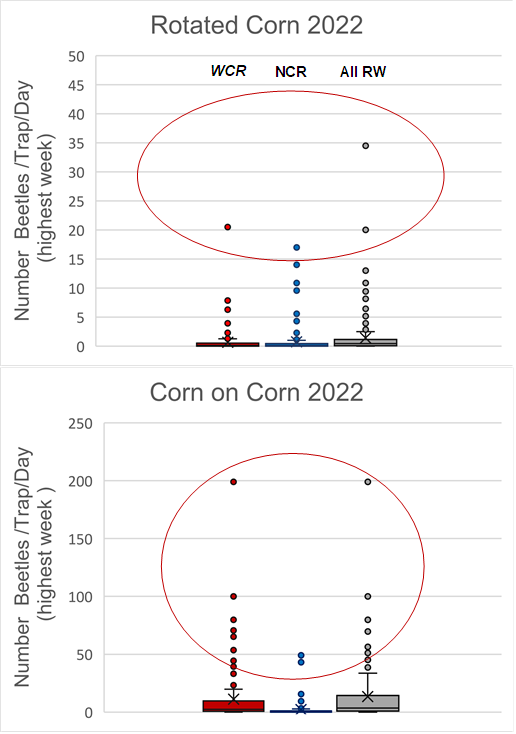
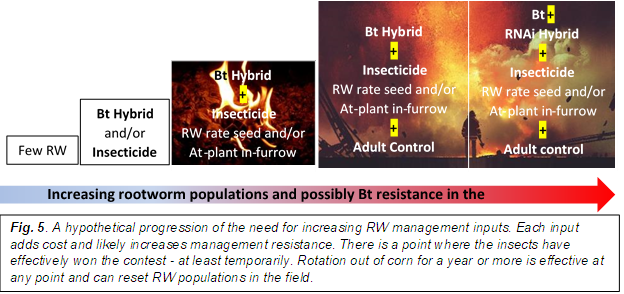
Summary
Southern Minnesota rootworm populations are currently high, particularly WCR in long-term corn.
Many fields going into corn in 2023 do not have RW problems. Beetle scouting in 2022 was needed to determine which ones they are.
Managing extremely high WCR rotations without using a year out of corn may prove expensive and difficult.
NCR populations may be increasing, particularly in some of the northern corn-growing areas.
Geographic areas with concentrations of continuous corn tend to have the most issues but any long-term continuous corn field should be scouted as potentially high risk for rootworm problems and managed accordingly.
RW management has a lot of moving parts. Single management tactics have limits, and most have been overcome by adaptive RWs. As result, there are thirteen “buts” in this article. They need to be there.
I managed to include eighteen references to RW resistance to Bt in this article. It just might be a thing.
For more information on scouting and management see: https://extension.umn.edu/corn-pest-management/scouting-corn-rootworm
Happy trails,
Bruce
Bruce Potter
University of Minnesota Extension IPM Specialist
University of Minnesota SW Research and Outreach Center
23669 130th Street
Lamberton, MN 56152
[email protected]
Cell: (507) 276-1184
https://swroc.cfans.umn.edu/ag/pest-management
